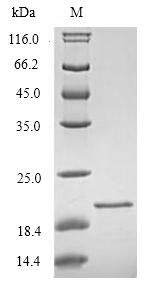The production of the recombinant human TREM2 protein with an N-terminal 6xHis-tag in E. coli includes cloning the gene that codes for the extracellular domain of the human TREM2, incorporating the His-tag sequence, into a suitable vector, transforming it into E. coli cells, and inducing protein expression. The positive E. coli cells are lysed to release the 6xHis-tagged recombinant TREM2 protein, which is subjected to nickel affinity chromatography purification. The purity of this recombinant TREM2 protein is assessed by SDS-PAGE, exceeding 90%.
The human TREM2 protein is a type I transmembrane glycoprotein predominantly expressed on myeloid-derived cells, including microglia, macrophages, dendritic cells, and osteoclasts. It plays a critical role in modulating the immune response and is involved in various biological functions, including cell survival, proliferation, differentiation, phagocytosis, and inflammatory responses [1]. TREM2 is essential in neuroinflammation and neurodegenerative diseases, including Alzheimer's disease, by regulating microglial activities linked to neurological disorders [2]. Furthermore, TREM2 facilitates adipogenesis and contributes to diet-induced obesity [3].
The TREM2 protein has been implicated in various functions, including regulating microglial responses to neuronal injury and impacting chemotaxis [4]. Moreover, TREM2 has been associated with synaptic pruning and normal brain connectivity, with reduced TREM2 protein expression observed in individuals within the age range corresponding to synaptic pruning in humans [5]. Studies have also highlighted the role of TREM2 in mediating microglial neuroprotection and phagocytic clearance of pathological proteins, indicating its involvement in neurodegenerative processes [6].
References:
[1] C. Liu, P. Li, H. Li, S. Wang, L. Ding, H. Wanget al., Trem2 regulates obesity-induced insulin resistance via adipose tissue remodeling in mice of high-fat feeding, Journal of Translational Medicine, vol. 17, no. 1, 2019. https://doi.org/10.1186/s12967-019-2050-9
[2] S. Carmona, K. Zahs, E. Wu, K. Dakin, J. Brás, & R. Guerreiro, The role of trem2 in alzheimer's disease and other neurodegenerative disorders, The Lancet Neurology, vol. 17, no. 8, p. 721-730, 2018. https://doi.org/10.1016/s1474-4422(18)30232-1
[3] M. Park, J. Yi, E. Kim, I. Yoon, E. Lee, H. Leeet al., Triggering receptor expressed on myeloid cells 2 (trem2) promotes adipogenesis and diet-induced obesity, Diabetes, vol. 64, no. 1, p. 117-127, 2014. https://doi.org/10.2337/db13-1869
[4] S. Jin, B. Benitez, C. Karch, B. Cooper, T. Skorupa, D. Carrellet al., Coding variants in trem2 increase risk for alzheimer's disease, Human Molecular Genetics, vol. 23, no. 21, p. 5838-5846, 2014. https://doi.org/10.1093/hmg/ddu277
[5] F. Mazaheri, N. Snaidero, G. Kleinberger, C. Madore, A. Daria, G. Werneret al., trem2 deficiency impairs chemotaxis and microglial responses to neuronal injury, Embo Reports, vol. 18, no. 7, p. 1186-1198, 2017. https://doi.org/10.15252/embr.201743922
[6] F. Filipello, R. Morini, I. Corradini, V. Zerbi, A. Canzi, B. Michalskiet al., The microglial innate immune receptor trem2 is required for synapse elimination and normal brain connectivity, Immunity, vol. 48, no. 5, p. 979-991.e8, 2018. https://doi.org/10.1016/j.immuni.2018.04.016






